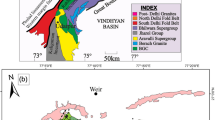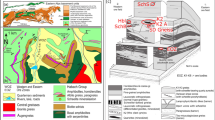Abstract
Composite dikes at Hell Hole Meadow, in the central Sierra Nevada, contain hybrids created by small scale mixing of andesitic and rhyolitic magmas. Early rhyolitic injections had partially solidified when subsequent andesitic magmas arrived and mixed with small increments of remnant rhyolitic magma. In major element chemistry, the hybrid rocks define linear MgO-variation diagrams that closely resemble those for the Half Dome, Mt. Givens, and Eagle Peak granodiorites. The patterns suggest that mixing of mafic and felsic magmas has been important in the evolution of these plutons.
Hornblendes in three Hell Hole Meadow hybrid rocks ranging from dacite to andesite display indistinguishable crystal-chemical variation patterns. The crystals apparently developed as phenocrysts of endmember andesitic magma prior to the mixing event and retained their compositional character in the hybridization event. Plutonic hornblendes (Dodge et al. 1968; Noyes et al. 1983) display crystal-chemical patterns nearly identical to those in the dike cores making it unlikely that the plutonic hornblendes represent restite of a complex lower crust.
Hornblende chemical data from a suite of rocks collected across the width of the compositionally zoned Half Dome granodiorite (Yosemite National Park) define clusters, like their Hell Hole Meadow counterparts, that are very similar to one another despite the large range in host rock bulk composition. Sr isotopic data (Kistler et al. 1986) and linear MgO-variation patterns for the major elements (Reid et al. 1983) suggest that the Half Dome is a mixture of high-alumina basalt and rhyolitic magmas. We propose that while the bulk chemistry of hybrid granodiorites is determined by the proportions of the constituent mafic and felsic magmas, the hornblendes in the mixed rocks largely retain compositions created in the mafic component prior to mixing. Mixing may occur either by incremental addition of felsic magma into a relatively large volume of mafic magma (as at Hell Hole Meadow), or by the chilling and subsequent disaggregation of mafic pillows in a largely felsic host.
Similar content being viewed by others
References
Bateman PC, Chappell BW (1979) Crystallization, fractionation, and solidification of the Tuolumne Intrusive Series, Yosemite National Park, California. Geol Soc Am Bull 90:465–482
Bateman PC, Nokleberg WJ (1978) Solidification of the Mt. Givens granodiorite, Sierra Nevada, California. J Geol 86:563–579
Bateman PC, Clark LD, Huber NK, Moore JG, Rinehart CD (1963) The Sierra Nevada batholith — a synthesis of recent work across the central part. Prof Pap US Geol Surv 414-D:46
Bryan WB (1986) Linked evolutionary data arrays: a logical structure for petrologic modelling of multi-source, multi-process magmatic systems. JGR 91(6):5891–5900
Chapman CA (1962) Diabase-granite composite dikes with pillowlike structure, Mount Desert Island, Maine. J Geol 70:539–564
Czamanske GJ, Wones DR (1973) Oxidation during magmatic differentiation, Finnmarka complex, Oslo area, Norway. Part 2. The mafic silicates. J Petrol 14:349–380
DePaolo DJ (1981) A neodymuim and strontium study of the Mezozoic calc-alkaline batholiths of the Sierra Nevada and Peninsular Ranges, California. J Geophys Res 86B11:10470–10488
Dodge FCW, Papike JJ, Mays RE (1968) Hornblendes from granitic rocks of the Sierra Nevada batholith, California. J Petrol 9:378–410
Gilbert MC, Helz RT, Popp RK, Spear FS (1982) Experimental studies of amphibole stability. In: Veblen DR, Ribbe PH (eds) Rev Mineral, vol 9B, Mineral Soc Am, pp 229–346
Helz RT (1973) Phase relations of basalts in their melting range at pH20=5 kb as a function of oxygen fugacity. Part I. Mafic phases. J Petrol 14:249–302
Hill RI, Silver LT, Taylor HP Jr (1986) Coupled Sr-O isotope variation as an indicator of source heterogeneity for the Northern Peninsular Ranges batholith. Contrib Mineral Petrol 92:351–361
Ingrin J, Poirier JP (1986) Transmission electron microscopy of ejecta from the XVIth century eruption of Souffriere, Guadeloupe; Microscopic evidence for magma mixing. J Volcanol Geotherm Res 28:161–174
Kistler RW, Peterman ZE (1973) Variations in Sr, Rb, K, Na and initial 87Sr/86Sr in Mezozoic granites and intruded wall rocks in central California. Geol Soc Am Bull 84:3489–3512
Kistler RW, Chappell BW, Peck DL, Bateman PC (1986) Isotopic variation in the Tuolumne Instrusive Suite, central Sierra Nevada, California. Contrib Mineral Petrol 94:205–220
Lockwood JP, Lydon PA (1975) Geologic map of the Mount Abbot quadrangle, central Sierra Nevada, California. USGS Geologic Quadrangle Map GQ-1155
Noyes HJ, Wones DR, Frey FA (1983) A tale of two plutons: petrographic and mineralogic constraints on the petrogenesis of the Red Lake and Eagle Peak plutons, central Sierra Nevada, California. J Geol 91:353–379
Pabst A (1928) Observations on inclusions in the granitic rocks of the Sierra Nevada. Bull Geol Univ Calif 17:325–368
Philpotts AR (1982) Compositions of immiscible liquids in volcanic rocks. Contrib Mineral Petrol 80:201–218
Reid JB Jr, Evans OC, Fates DG (1980) Quenched droplets of basaltic magma in granites of the Pliny Range, NH. Geol Soc Am 12:507
Reid JB Jr, Evans OC, Fates DG (1983) Magma mixing in granitic rocks of the central Sierra Nevada, California. Earth Planet Sci Let 66:243–261
Robinson P, Ross M, Jaffe HW (1971) Composition of the anthophyllite-gedrite series, comparisons of the gedrite-hornblende and the anthophyllite-gedrite sol vus. Am Mineral 56:1005–1041
Robinson P, Spear FS, Schumacher JC, Laird J, Klein C, Evans BW, Doolan BL (1982) Phase relations of metamorphic amphiboles: natural occurrence and theory. In: Veblen DR, Ribbe PH (eds) Rev Mineral, vol 9B, Mineral Soc Am
Taylor TR, Vogel TA, Wilband JT (1980) The composite dikes at Mt. Desert Island, Maine: an example of coexisting acid and basic magmas. J Geol 88:433–444
Vernon RH (1983) Restite, xenoliths and microgranitoid enclaves in granites. Proc R Soc NS Wales 116:77–103
Vernon RH (1984) Microgranitoid enclaves in granites: globules of hybrid magma quenched in a plutonic environment. Nature 309:438–439
Vogel TA, Wilband JT (1978) Coexisting acidic and basic melts: geochemistry of a composite dike. J Geol 86:353–371
Walker GPL, Skelhorn RR (1966) Some associations of acid and basic igneous rocks. Earth Sci Rev 2:93–109
Watson EB, Jurewicz SR (1984) Behavior of alkalies during diffusive interaction of granitic xenoliths with basaltic magma. J Geol 92:121–131
White AJR, Chappell BW (1977) Ultrametamorphism and granitoid genesis. Tectonophysics 43:7–22
Wiebe RA (1974) Coexisting intermediate and basic magmas, Ingonish, Cape Breton Island. J Geol 82:74–87
Wyllie PJ, Cox KG, Biggar GM (1962) The habit of apatite in synthetic systems and igneous rocks. J Petrol 3:238–242
Author information
Authors and Affiliations
Rights and permissions
About this article
Cite this article
Reid, J.B., Hamilton, M.A. Origin of Sierra Nevadan granite: evidence from small scale composite dikes. Contr. Mineral. and Petrol. 96, 441–454 (1987). https://doi.org/10.1007/BF01166689
Received:
Accepted:
Issue Date:
DOI: https://doi.org/10.1007/BF01166689




